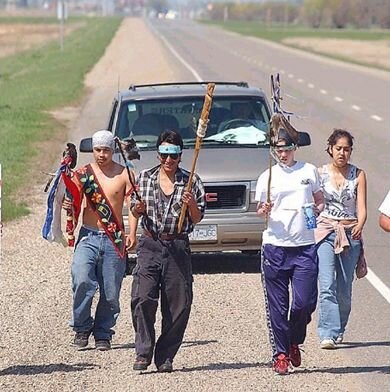High rate of suicide on Indian reservations near epidemic proportions
American Indians — By Tim Giago (Nanwica Kciji) on June 1, 2010 at 09:27I don’t know who said, “Suicide is a permanent solution to a temporary problem,” but it certainly makes sense.
Teen suicide, it would appear, is a problem throughout America, but it seems to happen more frequently among young Native Americans.
A “study” on any topic usually does not offer a solution, but a “study” that gets to the bottom of why so many young Indians are taking their own lives would at least lay the groundwork for the traditionalists seeking a solution.
Some would place the problem at the doorstep of the boarding schools where children were oftentimes forcibly taken from their traditional homes and placed in institutions designed to strip any Indian identity from their psyche. Shorn of hair, stripped of all cultural markers, forced to learn English and physically abused for speaking their own language, indoctrinated into a religion foreign to them, and forced to cut their ties to their tiospaye (traditional family group), in many cases the boarding school children grew up uncertain of their own identity.
Worse yet, many grew up ashamed of their culture and traditions because they had been force-fed the idea that their past was now meaningless and ties to their ancestors was akin to something evil. The shame and guilt foisted upon two or three generations of Native Americans became a part of a new culture; one that had many Indians searching for themselves and finding absolution in alcohol and drugs. The problems then became generational and the guilt and anger, enhanced by the abuse of alcohol and drugs, was visited upon the children and even the grandchildren of the ensuing generations. The abuses ran the gamut of sexual, spousal and child abuse that has brought so many dysfunctional families to the forefront in Indian Country.
Combine all of these problems with extreme poverty and you have sown the seeds of extreme depression. Indian children of today are often raised by their grandparents because they are the children of teenage mothers who have been abandoned by their boyfriends who in turn are the children of parents that lost all ties to their own traditions and culture.
The young go to movies, watch television and they see all of the modern technology that comes with cell phones, I-pods, and I-pads and they are exposed to the world of texting, twittering and tweeting, but find they are unable to afford these innovative technologies because of extreme poverty and oftentimes from the distance and isolation of their Indian reservations. This deprivation can instill depression in the young.
According to Richard Iron Cloud, Acting Director of the Sweet Grass Project on the Pine Ridge Indian Reservation in South Dakota, in 2009 there were nine successful suicides on the reservation; eight men and one woman with an average age of 29 years. “Men are more likely to carry out suicide attempts than women,” he said.
The Sweet Grass Project is halfway through its funding year and, as a very new project, it is feeling its way through small successes and foibles. After encouraging and enabling wicasa wakan (holy men) like Rick Two Dogs to visit the schools and hold meetings across the reservation with the young, Iron Cloud feels that the ensuing reduction in suicides is emblematic of their efforts. “The real success will come through strength in the community,” he said.
Iron Cloud is optimistic, but he was visibly upset at the suicide of a 16 year old girl on the reservation last week. “We have tried to set up a 24/7 hot line, but believe it or not, with unemployment on the reservation as high as 80 percent we are having a hard time finding experienced people to man the phones,” he said.
He believes that it is the trauma of speaking to the young people contemplating suicide that has caused such a high turnover in personnel. “In the past year we have lost 13 employees who said they just couldn’t take it anymore,” he said.
After the first rash of suicides in 2009, Oglala Sioux Tribal President, Theresa Two Bulls, declared a state of emergency and vowed to raise the money and create an atmosphere that would stem and hopefully, eliminate the problem.
Iron Cloud said, “We have a reservation larger than some of the smaller states like Rhode Island and getting our people trained in villages like Porcupine and Wanblee means having to provide them with transportation, fuel, food and lodging and this really creates a hardship for the volunteers.”
“It is always a matter of finding the money to carry out our project and we are always working on that end of it,” Iron Cloud said.
Another old saying goes, “If you think the government can fix everything, ask an Indian.” Iron Cloud and his dedicated staff need the money the government offers, but they intend to find a solution to the problem of the high suicide rate on the reservation by going back to the culture, traditions and the spirituality of their ancestors. So far it seems to be working.
Tags: american indian, indian, Indian country, native americans, public health, Teen Suicides In Indian CountryAuthor: Tim Giago (Nanwica Kciji) (34 Articles)

Tim Giago, an Oglala Lakota, is the editor and publisher of Native Sun News. He is the founder and first president of the Native American Journalists Association. He was a Nieman Fellow at Harvard with the Class of 1991. He was inducted into the South Dakota Newspaper Hall of Fame in 2008. His latest book, “Children Left Behind” is available through [email protected].



 Share This
Share This Tweet This
Tweet This Digg This
Digg This Save to delicious
Save to delicious Stumble it
Stumble it





 From Somalia to Denver, the long way
From Somalia to Denver, the long way







